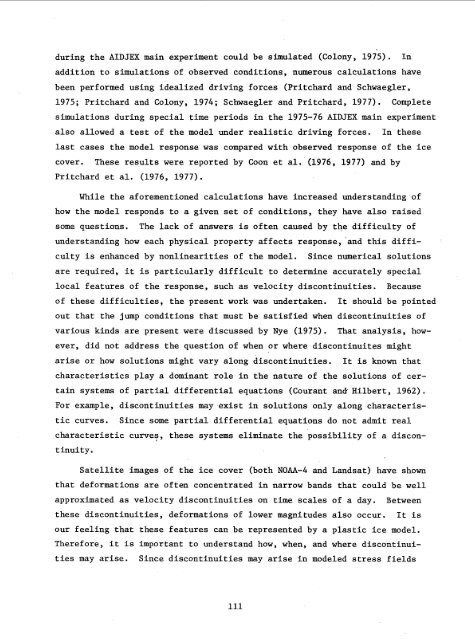AIDJEX Bulletin #40 - Polar Science Center - University of Washington
AIDJEX Bulletin #40 - Polar Science Center - University of Washington
AIDJEX Bulletin #40 - Polar Science Center - University of Washington
You also want an ePaper? Increase the reach of your titles
YUMPU automatically turns print PDFs into web optimized ePapers that Google loves.
during the <strong>AIDJEX</strong> main experiment could be simulated (Colony, 1975).<br />
addition to simulations <strong>of</strong> observed conditions, numerous calculations have<br />
been performed using idealized driving forces (Pritchard and Schwaegler,<br />
1975; Pritchard and Colony, 1974; Schwaegler and Pritchard, 1977). Complete<br />
simulations during special time periods in the 1975-76 <strong>AIDJEX</strong> main experiment<br />
also allowed a test <strong>of</strong> the model under realistic driving forces.<br />
last cases the model response was compared with observed response <strong>of</strong> the ice<br />
cover. These results were reported by Coon et al. (1976, 1977) and by<br />
Pritchard et al. (1976, 1977).<br />
In<br />
In these<br />
While the aforementioned calculations have increased understanding <strong>of</strong><br />
how the model responds to a given set <strong>of</strong> conditions, they have also raised<br />
some questions.<br />
The lack <strong>of</strong> answers is <strong>of</strong>ten caused by the difficulty <strong>of</strong><br />
understanding how each physical property affects response, 'and this diffi-<br />
culty is enhanced by nonlinearities <strong>of</strong> the model.<br />
are requi.red, it is particularly difficult to determine accurately special<br />
local features <strong>of</strong> the response, such as velocity discontinuities. Because<br />
<strong>of</strong> these difficulties, the present work was undertaken.<br />
out that the jump conditions that must be satisfied when discontinuities <strong>of</strong><br />
various kinds are present were discussed by Nye (1975).<br />
Since numerical solutions<br />
It should be pointed<br />
That analysis, how-<br />
ever, did not address the question <strong>of</strong> when or where discontinuites might<br />
arise or how solutions might vary along discontinuities.<br />
It is known that<br />
characteristics play a dominant role in the nature <strong>of</strong> the solutions <strong>of</strong> cer-<br />
tain systems <strong>of</strong> partial differential equations (Courant an& Hilbert, 1962).<br />
For example, discontinuities may exist in solutions only along characteris-<br />
tic curves. Since some partial differential equations do not admit real<br />
characteristic curves, these systems eliminate the possibility <strong>of</strong> a discont<br />
inuity .<br />
Satellite images <strong>of</strong> the ice cover (both NOAA-4 and Landsat) have shown<br />
that deformations are <strong>of</strong>ten concentrated in narrow bands that could be well<br />
approximated as velocity discontinuities on time scales <strong>of</strong> a day. Between<br />
these discontinuities, deformations <strong>of</strong> lower magnitudes also occur. It is<br />
our feeling that these features can be represented by a plastic ice model.<br />
Therefore, it is important to understand how, when, and where discontinui-<br />
ties may arise. Since discontinuities may arise in modeled stress fields<br />
111








